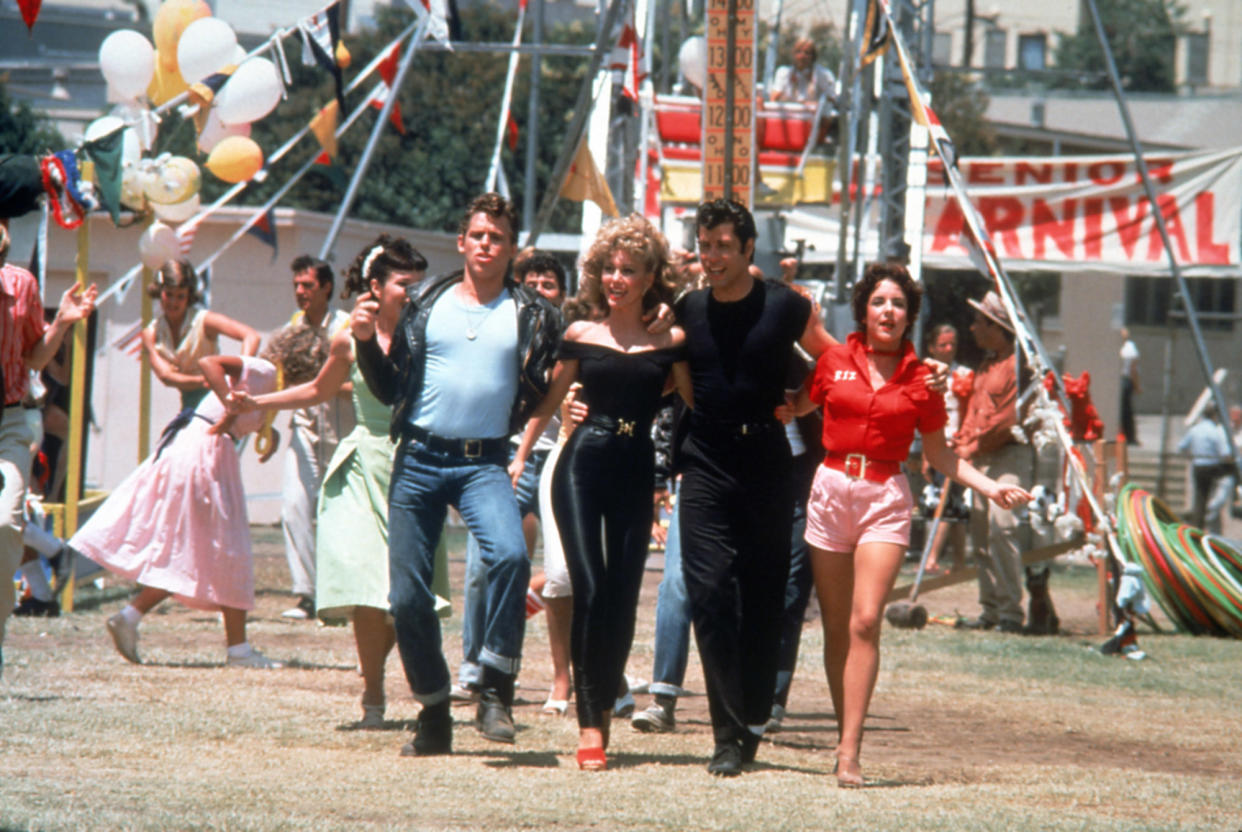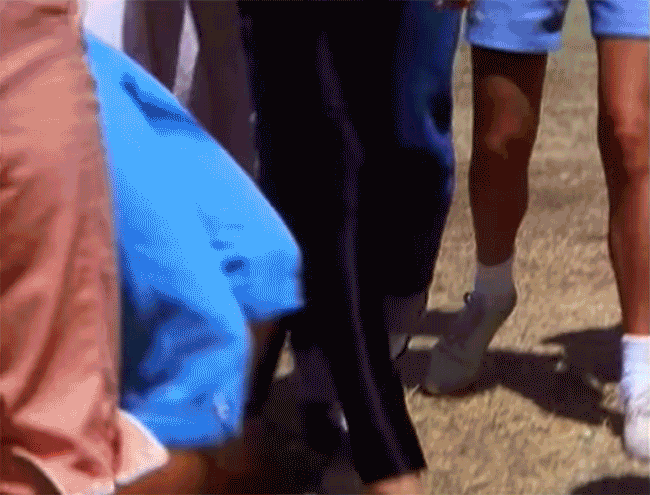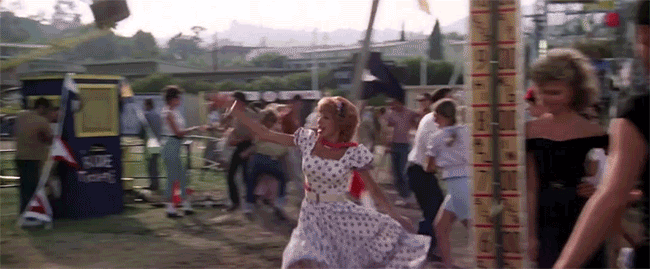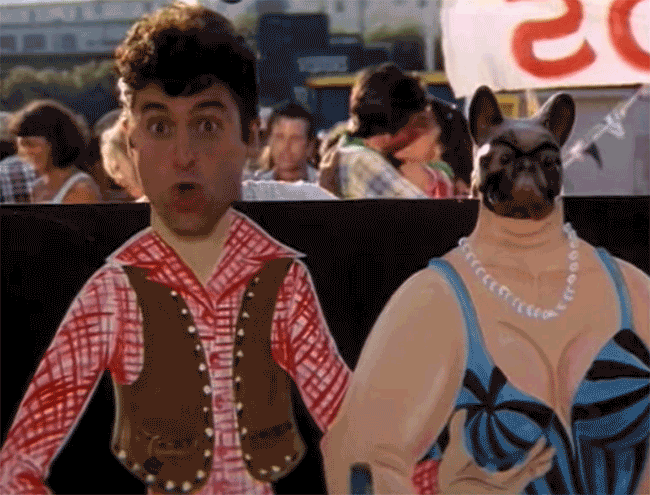'Grease' turns 40: The Pink Ladies and T-Birds remember the wild ride filming the carnival finale

After all the high school drama (and accompanying musical numbers), the carnival scene in Grease gives the students of Rydell High a fairy-tale ending. Sandy, the virginal duckling, transforms into a red-stiletto-wearing swan; bad-girl Rizzo’s pregnancy scare vanishes; the Pink Ladies and the T-Birds pair off, as if under a love spell, and reformed delinquent Danny drives his shiny Ford convertible (technically Kenickie’s, but who cares?) into the sky, with Sandy by his side. In another film, it might all be too much. But for a musical like this, it’s perfect.
Not that there are other musicals quite like this one. Grease hit theaters in 1978, at a time when 1950s nostalgia was hot but movie musicals were decidedly not. Based on a raunchy Broadway show, Randal Kleiser’s film had an unproven cast (many members, including John Travolta, had appeared in the stage musical), pastiche musical numbers (albeit with sometimes filthy lyrics), and a tone so earnest you could barely make out the outline of a tongue gently planted in its cheek. Nevertheless, Grease was a hit — not just a hit but a sensation, the biggest film of the year and the highest-grossing movie musical of the century.

Forty years later, Grease is more beloved than ever. One could name many reasons — the catchy songs, the spirited dance numbers, the ageless cool of Travolta and Olivia Newton-John — but ask the cast, and they’ll tell you that the film is magic. The feel-good buzz that the audience gets watching Grease is exactly what the actors felt while they were making it. It’s what kept them dancing in leather jackets in the brutal Los Angeles heat. It’s what made them friends for life.
And nowhere is that joy more palpable than in the carnival scene, a 10-minute outdoor romp that brings the whole cast together for two last musical numbers: the Travolta/Newton-John duet “You’re the One That I Want” and the high-energy group number “We Go Together.” To celebrate the film’s upcoming 40th anniversary (June 16), and next Tuesday’s release of a new Blu-ray edition packaged in a miniature Rydell yearbook, Yahoo Entertainment spoke with the original T-Birds and Pink Ladies (with the exception of Travolta, Newton-John, Stockard Channing, and the late Jeff Conaway, who played Kenickie) to assemble an oral history of Grease’s unforgettable final scene.
Watch “You’re the One That I Want,” the duet with John Travolta and Olivia Newton-John in the carnival scene:
The carnival scene was shot in the summer of 1977, toward the end of filming, at the football field of John Marshall High School (one of three schools that stood in for the fictional Rydell High) . The cast had been rehearsing the final number for weeks, but didn’t realize until they arrived on set that producer Allan Carr had rented an actual, fully-operational carnival.
Kelly Ward (Putzie): Just coming to the set and seeing a full carnival laid out — for a 20-year-old kid, that’s like a party ready to happen.
Michael Tucci (Sonny): It was just a big party. It was like we weren’t even shooting a movie; they were just shooting this wonderful experience. And we went on all the rides. I bought Eve Arden [the Golden Age Hollywood star who played Principal McGee] a lot of cotton candy.

Ward: The carnival ride operators were willing to let us ride in between takes and when they were setting up shots. So I talked Barry [Pearl, who played Doody] and Michael into going on The Octopus. And 10 seconds into that, Michael started screaming, “Let me off, let me off, I’m gonna throw up, I’m gonna throw up!” And I said, “Don’t let him off, we can keep this going!” I thought he was kidding. But he did not like that at all. I, on the other hand, could have stayed on it all day.
Barry Pearl (Doody): The three of us are sitting in this one compartment and it spins and — and it’s not that I get sick to my stomach; I just don’t like that whipping around. And I’m yelling and screaming to the operator, “Turn it off!” He thinks I’m having a good time. I can’t remember if Michael wanted off too because I was too busy yelling at the operator to stop.
Didi Conn (Frenchie): We never rehearsed having a Ferris wheel. So I didn’t know that I was going to be on the Ferris wheel with Stockard [Channing, who played Rizzo] when she says she’s not PG, and it was so great, I couldn’t wait for it to come down so we could tell everybody!

Jamie Donnelly (Jan): A lot of people would come in and go, “Oh, I’d love to be on the Ferris wheel.” Kelly and I had the foresight to decide we would go on a ride that stayed on one level when we are singing and clapping our hands — it would go forward and back, and forward and back. Once you were on a ride, that’s where you had to be while they shot everything else that was happening at that time, so that if they caught you in the background you had to be on the right ride. There were a lot of people who were sorry that they picked exciting rides when the day began.

Conn: Dinah, was it you in the shot with Eve Arden and it pans up from the cotton candy?
Dinah Manoff (Marty): To those perfect boobs I had, yeah.
Conn: Well, that was supposed to be me with blue hair matching the cotton candy. And I said, “No, I don’t want to do that.” They said, “What? You’ve got to have blue hair.” And I said no, and I started to cry, “Don’t make me into a joke!” And that’s why you did that scene.
Manoff: I didn’t know that. I never knew.

Early in the carnival scene, the T-Birds visit a pie-throwing booth. They try to nail Coach Calhoun (played by comedy legend Sid Caesar) with whipped-cream pies, but no one hits him until school nerd Eugene (Eddie Deezen) gives it a go.
Tucci: That was hysterical. I think we spent two hours just throwing pies at each other.
Watch the opening of the carnival scene:
Pearl: They needed to do a close-up. You see Eddie throw the pie, then they cut to Sid getting the pie. It’s really not Eddie’s pie that hits him. So I said, “Oh, I can hit him, no problem!” So I stood fairly close and they called action and I threw the pie — must have been three feet away from him — and it missed! So I grabbed another pie — and it missed. And I grab a third pie, and they go, “Whoa, whoa! They don’t want to waste pies! Stop, stop!” [Laughs] I wanted to be the hero, you know? They wound up having one of the production folks actually throw the pie.
Olivia Newton-John, who played Sandy, had only starred in one major film before Grease — a 1970 British sci-fi flop called Toomorrow. As an actress, she was an unknown quantity. As a musician, however, the Australian-born singer was an international star, whose No 1. singles included “I Honestly Love You” and “Have You Never Been Mellow.” Her Grease co-stars, many of whom were Broadway veterans, liked and admired their leading lady, but none of them were sure if she would pull off Sandy’s transformation into a cigarette-smoking, leather-clad vamp until the day she shot the scene.
Manoff: The thing I remember the most is seeing Olivia in that outfit for the first time.
Ward: I think I caught her walking out of her trailer. And she was, if you can believe it, even more stunning in person than she is on film in that outfit.
Pearl: We didn’t recognize her. You know she was in those tight black pants that she had to be sewn into. And yeah, you sort of couldn’t keep your eyes off her. I kept looking around to see if people were watching me watching her.
Conn: And how much she loved doing it! She looooved it. She was such a goody-goody, you know, not only in the movie but as a major star.

Donnelly: She was amazing. I could say nothing but good things, really, about Olivia and pretty much anybody in that show. But Olivia was so respectful of all of us. And of course, she was a big star. She was an astonishing young woman already, really, when you think of it: an American country singing sensation from Australia. But she was very much like, “You guys have more experience in this than I do, so if you have any tips or any thoughts or anything, if you notice anything you want to tell me, I’m open to hearing anything that you want to suggest.” And that is not typical of any leading lady, to open herself up like that. She was just gracious and lovely.

Like Newton-John, Travolta was already a star, but not a movie star — at least, not yet. For more than two years, he had been getting laughs and achieving teen-idol status on the ABC high-school comedy Welcome Back, Kotter. The 1976 TV movie The Boy in the Plastic Bubble, directed by Kleiser and co-starring Kelly Ward, gave audiences a first hint that Travolta had bigger things in store. But it was the one-two punch of Saturday Night Fever (released in December 1977) and Grease that would send him into the stratosphere. Travolta shot the two films essentially back to back, and while many of his Grease co-stars had known him since their theater days, they realized that they were watching a star being born.
Tucci: John was like, between a cloud and cream cheese. He’s just so natural. He just goes with it. It’s so delicious to watch him. Especially when the charm is there — forget it! Olivia was already there, but you just saw John going right up the ladder with her.
Donnelly: We had been friends for years. John and I knew each other very well, [and] had gone dancing many times before we ever danced onscreen. I knew him and I knew his family. You know, he’s the most loving, gentle, generous, fun-loving — not in any way stuck-up. When you see the characters in Grease, I think one of the reasons it works so well is that most of us are really very essentially like the characters. And when you see the openness of Danny Zuko, who’s trying to act like a tough guy but underneath is really just a sweetheart — that’s John. John is a sweetheart.

Ward: I knew John from working with him on Boy in the Plastic Bubble. I played kind of his nemesis, or at least the guy who was interested in the girl he was interested in. So that’s where we met, and we had a nice relationship and a good friendship.
Tucci: When I was involved with the Broadway play Grease and I saw John onstage — he came across the stage, I mean beautiful, [and] sang the crap out of this “Magic Changes” song that’s so difficult to sing. And you’d come out and there were maybe 10 people at the stage door. And then there were 20. Then more. So there was something there. And when you were around him, there was this nice aura about him that was very charming and relaxed. … Travolta was very connected to his feelings. He had a nice background with the Italian thing: the whole family was around him, very good, and nicely protective of him. But you saw it. I saw it back then.
Ward: It’s hard to put your finger on, but it’s charisma, it’s what it boils down to. It was more distilled and more concentrated when we did Grease than it was when John did Boy in the Plastic Bubble. He did evolve. And it’s not a fundamental change in the way he interacted with people; it’s more of a sense of self, and what’s possible, I suppose.
Donnelly: I actually went with him too to the opening of Saturday Night Fever. I was there for that red carpet before the Grease one. And it was like all of a sudden, the lights got so darn bright standing next to John, and people wanted to either push me toward him, saying, “Oh, are you his girlfriend?” or “If you aren’t, get out of the shot because we’re getting John here!” It was very, very different than it had been ever before. And that didn’t change. We couldn’t just go and dance anyplace we wanted to anymore.
The first musical number of the carnival scene is the Sandy-Danny duet “You’re the One That I Want,” written not by the original Broadway songwriting team of Jim Jacobs and Warren Casey but by Newton-John’s go-to songwriter, John Farrar. The song was a last-minute replacement for “All Choked Up,” the homage to Elvis Presley’s “All Shook Up” that ended the stage play. The number was played for most of the cast on the day they shot it, and quickly staged by choreographer Pat Birch in the carnival’s fun house.
Ward: One of the glaring omissions of our very intense rehearsal period was the finale of the play, which was “All Choked Up.” We didn’t rehearse it, it was pretty apparent we weren’t going to do that number, but nobody had spoken about what the final song was going to be.
Pearl: The next thing you know we’re out on the set and they bring this song out. And before they brought it out, John and Olivia had this inside thing that they did with each other. Apparently, they had recorded the song — I want to say the night before — and they were joking with each other because of the way John went, “You’re the one that I wa-ooont! Wa-oont!” And they kept doing that. And we thought, what are they doing? They just kept laughing with each other. And the next thing you know they played this great song John Farrar composed for us. And Pat said, “Let’s choreograph this on the spot.” And she did.
Ward: It was lightning-fast work and nobody was really quite sure how it would play, because it’s such a different kind of music than the rest of the score. And nonetheless everybody threw themselves into it.

Pearl: Here’s the thing: We [the T-Birds and Pink Ladies] do not sing on “You’re the One That I Want.” It was a song we had never heard before, and we all lip-synched the “you’re the one, the one-a-one, woo hoo hoo.” In fact, if you notice toward the end of the song where we’re all behind cut-outs and I’m singing to the ceramic dog, I’m really over-enunciating. When you lip sync to your own voice, you don’t really do that; it’s easier to lip sync to yourself.
Watch “We Go Together,” the musical finale of the carnival scene:
The second musical number, “We Go Together,” was a much bigger production. In addition to the leads, it featured Birch’s ensemble of 20 professional dancers (including Andy Tennant, future director of Hitch) and a chorus of Rydell students, all making a mad dash across the high school football field while singing and dancing in the extreme heat. Between the crowd and the cameras, the scene could get chaotic — and it sent one cast member in the hospital.
Ward: There were people who were passing out from dehydration and heat exhaustion and so forth during that sequence. It was an oppressively hot set because there was no place to hide. There was no shade, really. It was high summer and we were outdoors and it was hot. Not a lot of cloud cover, and they dealt with that in a number of different ways, with silks and things. But yeah, it was hot. Sunburns abounded. I got my scalp burned on a number of occasions because I foolishly didn’t put sunblock on the part in my hair, like down the middle. So the part had to shift every now and then, and then I had major-league dandruff from my flaking scalp for much of the film. It hurt like the devil too.
Donnelly: They were giving out salt pills all the time, and that was supposed to keep people from fainting.
Pearl: They had to keep spraying the top of our heads with Sea Breeze, which was an astringent that you put on sunburn.
Conn: Some of the dancers were fainting because John would revive them. He was spraying Sea Breeze, and only when John did it, did people revive. It was miraculous. [Laughs]
Donnelly: We were pounding that field so hard. It looks like a nice green field, but that was all sprayed bright green, as I recall. You know — it’s L.A., it’s brown, and it was stomped on a whole lot in the scene. So they would come through and they would spray. So that beautiful green lawn is sprayed.

Tucci: I’m pretty sure it was two weeks of rehearsal. I know it was long. And it was a lot of fun. They had key dancers like Carol Culver — she did the Broadway show; this guy Danny Levan; he ended up working for the L.A. Ballet. You’ll see him as the ending of that number’s coming; he’s with a green shirt, right in the middle. Oh, beautiful guy, beautiful dancer. I mean, they could have put a ballet in Grease.
Ward: The bulk of the dancey-dance stuff was thrown to the 20 dance supporting characters. There’s an ensemble moment where the camera is tracking back and they’re dancing toward the camera with Danny Levans and Helena Andreyko in the center of the group. It was [for us] a lot of pulling faces, monkey-walking; just kind of manic behavior. You know, dog-piling in the middle of the field. So it wasn’t so much choreographed as it was just an exuberant romp. I don’t remember a lot of specifics about it being a rigorous dance per se as much as it’s just a strut toward the camera.
Manoff: I remember trying not to split my pants — those white pants — because I’d been sewn into them.
Tucci: They had cameras in the sky, they had cameras on things, they had cameras all over the place, and they were filming a big, big party. And once in a while doing close-ups.
Donnelly: Andy Tennant was one of the dancers who did a lot of the gymnastic tricks. And part of a camera came across and caught him mid-air, as I recall, and he got knocked out.
Andy Tennant (ensemble dancer): No, I tumbled into the crane. What happened was they changed the movement on the Chapman crane but they didn’t tell us. So when I was tumbling, I was supposed to be tumbling toward the crane. I would do like, round-off, flip-flop, flip-flop, flip-flop, back flip, and I would land about 10 feet in front of the crane, and then join the group or whatever. And then Randal Kleiser, the director, moved the crane and moved up the camera arm. And so when I did the back flip, I actually landed on the crane and on the cameraman and the actual camera itself. I got pretty banged up and they sent me to the hospital. When I came back after I was given the all-clear, I was met at the location by the Paramount lawyers [laughs] so that I would sign a piece of paper that said I wasn’t going to sue them.
Pearl: When you see us all running to the camera and then we kind of end up in a clump and I’m on my knees behind Didi — well, we ended the day and I was on Didi’s right side. The next day or whatever, when they picked that shot up, they put me on Didi’s left. I said, “No, I ended on her right.” And they argued with me. So I went to her left. Well, when you look at the film, it flips — I go from her right to her left. I was right!

Donnelly: One of the things that I look at when I see the scene now is — remember at the very end when the car takes off and we’re waving up into the sky? I jump up onto Kelly’s shoulder from the ground. He was a trained ballet dancer, and you just buy it! I mean, that is a dream partner who can manage to help you hop up onto their shoulder from the ground. It looks effortless.
Perhaps the Rydell High School seniors were deluding themselves when they sang that they’d be “together forever.” But for the Grease cast, those lyrics were prophetic. Most of the actors remain good friends, and Grease has been a continual presence in their lives thanks to the enduring love of fans.
Tucci: When I saw the film for the first time, I hated it. Hated it. I never understood why it was such a hit. But then with the experience of making the movie, wow, I didn’t care what it was — this was just a party; this was a wonderful time. … My wife said the other day, “What a nice perk for you at this point in your life.” Sunday’s my birthday — 72, aye yi yi. From that point of view, it’s nice. It’s like a great remembrance. It was a very positive time.
Pearl: Through the years people would ask us about any kind of sordid details, and there really weren’t any. We all got along. It was 15 weeks of a labor of love. You see it when you watch it. So I think that’s part of its appeal — you see this comradery all over the place. It’s kind of like the Rockettes kicking in time: It always gets applause because you have, what, 30 disparate egos kicking at the same time. We were that in sync. Not literally kicking at the same time, but immersed in our characters, doing our job, having fun.
Tennant: We were all pretty much a big family on that show, the dancers and the Pink Ladies and the T-Birds. It was just magical to be on a movie lot when all these things were being made: Star Trek, Heaven Can Wait. … I remember at one point we played the cast of The Bad News Bears in a softball game. They did things like that back then! It was a blast. … I’m still friends with a lot of people on that movie.
Conn: I see Olivia every time she performs on the East Coast. She always says, “We all have a friend who’s very special, and I have one in the audience.” Everybody starts screaming, and I get to go up there and be a rock star for five minutes. I have to admit it — I love it.
Manoff: If only I had felt as adorable then as I look back and see us all now! All I remember thinking then was how everyone else is cuter and more talented and prettier. And then I look back now and go, “I was freaking adorable!” Didi still has her jacket. I wasn’t smart enough to save my jacket.
Grease: 40th Anniversary Edition is available on Blu-ray, DVD, and 4K Ultra HD on Tuesday.
Read more from Yahoo Entertainment:

